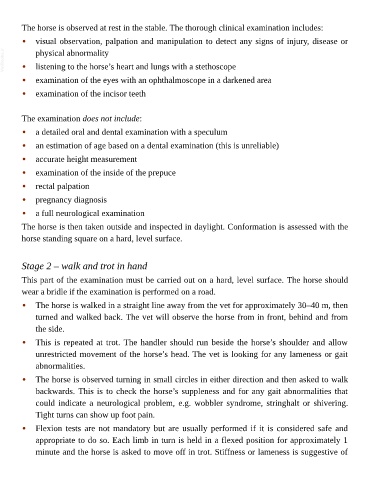Page 1059 - The Veterinary Care of the Horse
P. 1059
The horse is observed at rest in the stable. The thorough clinical examination includes:
• visual observation, palpation and manipulation to detect any signs of injury, disease or
VetBooks.ir • physical abnormality
listening to the horse’s heart and lungs with a stethoscope
• examination of the eyes with an ophthalmoscope in a darkened area
• examination of the incisor teeth
The examination does not include:
• a detailed oral and dental examination with a speculum
• an estimation of age based on a dental examination (this is unreliable)
• accurate height measurement
• examination of the inside of the prepuce
• rectal palpation
• pregnancy diagnosis
• a full neurological examination
The horse is then taken outside and inspected in daylight. Conformation is assessed with the
horse standing square on a hard, level surface.
Stage 2 – walk and trot in hand
This part of the examination must be carried out on a hard, level surface. The horse should
wear a bridle if the examination is performed on a road.
• The horse is walked in a straight line away from the vet for approximately 30–40 m, then
turned and walked back. The vet will observe the horse from in front, behind and from
the side.
• This is repeated at trot. The handler should run beside the horse’s shoulder and allow
unrestricted movement of the horse’s head. The vet is looking for any lameness or gait
abnormalities.
• The horse is observed turning in small circles in either direction and then asked to walk
backwards. This is to check the horse’s suppleness and for any gait abnormalities that
could indicate a neurological problem, e.g. wobbler syndrome, stringhalt or shivering.
Tight turns can show up foot pain.
• Flexion tests are not mandatory but are usually performed if it is considered safe and
appropriate to do so. Each limb in turn is held in a flexed position for approximately 1
minute and the horse is asked to move off in trot. Stiffness or lameness is suggestive of

